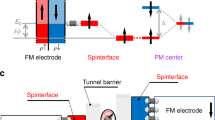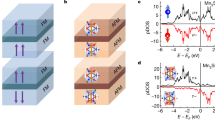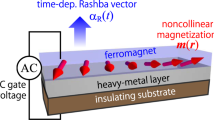Abstract
Heat-driven engines are hard to realize in nanoscale machines because of efficient heat dissipation1. However, in the realm of spintronics, heat has been employed successfully—for example, heat current has been converted into a spin current in a NiFe|Pt bilayer system2, and Joule heating has enabled selective writing in magnetic memory arrays3. Here, we use Joule heating in nanoscale magnetic tunnel junctions to create a giant spin torque due to a magnetic anisotropy change. Efficient conversion from heat dynamics to spin dynamics is obtained because of a large interfacial thermal resistance at an FeB|MgO interface. The heat-driven spin torque is equivalent to a voltage-controlled magnetic anisotropy4,5 of approximately 300 fJ V−1 m−1, which is more than twice the value reported in a (Co)FeB|MgO system6,7. We demonstrate an electric microwave amplification gain of 20% in a d.c. biased magnetic tunnel junction as a result of this spin torque. While electric d.c. power amplification in spintronic devices has been realized previously8, the microwave amplification was limited to relatively small amplification gains (G = radiofrequency output voltage/radiofrequency input voltage) and has never exceeded 1 (refs 9,10,11,12,13). A magnetic tunnel junction driven by radiofrequency spin transfer torque using ferromagnetic resonance enabled a relatively large gain of G ≈ 0.55 (ref. 12). Furthermore, radiofrequency spin waves were tuned by the spin transfer effect14,15. The heat-driven giant spin torque in the FeB|MgO16,17 magnetic tunnel junction, which shows a large magnetization precession and resistance oscillation under a d.c. bias, overcomes the above limitations and provides a gain larger than 1.
This is a preview of subscription content, access via your institution
Access options
Access Nature and 54 other Nature Portfolio journals
Get Nature+, our best-value online-access subscription
$29.99 / 30 days
cancel any time
Subscribe to this journal
Receive 12 print issues and online access
$259.00 per year
only $21.58 per issue
Buy this article
- Purchase on Springer Link
- Instant access to full article PDF
Prices may be subject to local taxes which are calculated during checkout




Similar content being viewed by others
Data availability
The data that support the plots within this paper and other findings of this study are available from the corresponding author upon reasonable request.
References
Feynman, R. P. There’s plenty of room at the bottom. Eng. Sci. 23, 22–36 (1960).
Uchida, K. et al. Observation of the spin Seebeck effect. Nature 455, 778–781 (2008).
Beech, R. S., Anderson, J. A., Pohm, A. V. & Daughton, J. M. Curie point written magnetoresistive memory. J. Appl. Phys. 87, 6403 (2000).
Weisheit, M. et al. Electric field–induced modification of magnetism in thin-film ferromagnets. Science 315, 349–351 (2007).
Maruyama, T. et al. Large voltage-induced magnetic anisotropy change in a few atomic layers of iron. Nat. Nanotech. 4, 158–161 (2009).
Nozaki, T. et al. Voltage-induced magnetic anisotropy changes in an ultrathin FeB layer sandwiched between two MgO layers. Appl. Phys. Express 6, 073005 (2013).
Li, X. et al. Enhancement of voltage-controlled magnetic anisotropy through precise control of Mg insertion thickness at CoFeB|MgO interface. Appl. Phys. Lett. 110, 052401 (2017).
Konishi, K. et al. Current-field driven ‘spin transistor’. Appl. Phys. Express 2, 063004 (2009).
Kasai, S. et al. Three-terminal device based on the current-induced magnetic vortex dynamics with the magnetic tunnel junction. Appl. Phys. Express 1, 091302 (2008).
Nozaki, T. et al. RF amplification in a three-terminal magnetic tunnel junction with a magnetic vortex structure. Appl. Phys. Lett. 95, 022513 (2009).
Tomita, H., Maehara, H., Nozaki, T. & Suzuki, Y. Negative dynamic resistance and rf amplification in magnetic tunnel junctions. J. Magn. 16, 140–144 (2011).
Xue, L. et al. Conditions for microwave amplification due to spin–torque dynamics in magnetic tunnel junctions. Appl. Phys. Lett. 99, 022505 (2011).
Konishi, K. et al. Radio-frequency amplification property of the MgO-based magnetic tunnel junction using field-induced ferromagnetic resonance. Appl. Phys. Lett. 102, 162409 (2013).
Kajiwara, Y. et al. Transmission of electrical signals by spin-wave interconversion in a magnetic insulator. Nature 464, 262 (2010).
Evelt, M. et al. High-efficiency control of spin-wave propagation in ultra-thin yttrium iron garnet by the spin–orbit torque. Appl. Phys. Lett. 108, 172406 (2016).
Kubota, H. et al. Enhancement of perpendicular magnetic anisotropy in FeB free layers using a thin MgO cap layer. J. Appl. Phys. 111, 07C723 (2012).
Miwa, S. et al. Highly sensitive nanoscale spin–torque diode. Nat. Mater. 13, 50–56 (2014).
Nozaki, T. et al. Electric-field-induced ferromagnetic resonance excitation in an ultrathin ferromagnetic metal layer. Nat. Phys. 8, 491–496 (2012).
Zhu, J. et al. Voltage-induced ferromagnetic resonance in magnetic tunnel junctions. Phys. Rev. Lett. 108, 197203 (2012).
Yuasa, S., Nagahama, T., Fukushima, A., Suzuki, Y. & Ando, K. Giant room-temperature magnetoresistance in single-crystal Fe/MgO/Fe magnetic tunnel junctions. Nat. Mater. 3, 868–871 (2004).
Parkin, S. S. P. et al. Giant tunnelling magnetoresistance at room temperature with MgO (100) tunnel barriers. Nat. Mater. 3, 862–867 (2004).
Kiselev, S. I. et al. Microwave oscillations of a nanomagnet driven by a spin-polarized current. Nature 425, 380–383 (2003).
Ishibashi, S. et al. Large diode sensitivity of CoFeB/MgO/CoFeB magnetic tunnel junctions. Appl. Phys. Express 3, 073001 (2010).
Petit, S. et al. Spin-torque influence on the high-frequency magnetisation fluctuations in magnetic tunnel junctions. Phys. Rev. Lett. 98, 077203 (2007).
Tulapurkar, A. A. et al. Spin-torque diode effect in magnetic tunnel junctions. Nature 438, 339–342 (2005).
Böhnert, T. et al. Influence of the thermal interface resistance on the thermovoltage of a magnetic tunnel junction. Phys. Rev. B. 95, 104441 (2017).
Shiota, Y. et al. Induction of coherent magnetisation switching in a few atomic layers of FeCo using voltage pulses. Nat. Mater. 11, 39–43 (2012).
Kanai, S. et al. Electric field-induced magnetisation reversal in a perpendicular-anisotropy CoFeB-MgO magnetic tunnel junction. Appl. Phys. Lett. 101, 122403 (2012).
Grezes, C. et al. Ultra-low switching energy and scaling in electric-field-controlled nanoscale magnetic tunnel junctions with high resistance-area product. Appl. Phys. Lett. 108, 012403 (2016).
Kozioł-Rachwał, A. et al. Enhancement of perpendicular magnetic anisotropy and its electric field-induced change through interface engineering in Cr/Fe/MgO. Sci. Rep. 7, 5993 (2017).
Acknowledgements
This research was supported by Bilateral Programs (MEXT), MIC, the ImPACT programme of the Council for Science, Technology, and Innovation (Cabinet Office, Government of Japan) and JSPS KAKENHI (grant no. JP16H03850).
Author information
Authors and Affiliations
Contributions
M.G., Y.W. and U.K.O. performed the experiments and analysis. N.S. and B.D. performed the numerical simulation of the thermal distribution. H.K., K.Y., A.F. and S.Y. prepared the sample. The experiments and analysis were supervised by S.M. and Y.S. Y.S. conceived and designed the experiments and conducted the theoretical study.
Corresponding author
Ethics declarations
Competing interests
The authors declare no competing interests.
Additional information
Publisher’s note: Springer Nature remains neutral with regard to jurisdictional claims in published maps and institutional affiliations.
Supplementary information
Supplementary Information
Supplementary Figures 1–4, Supplementary Tables 1–3
Rights and permissions
About this article
Cite this article
Goto, M., Wakatake, Y., Oji, U.K. et al. Microwave amplification in a magnetic tunnel junction induced by heat-to-spin conversion at the nanoscale. Nature Nanotech 14, 40–43 (2019). https://doi.org/10.1038/s41565-018-0306-9
Received:
Accepted:
Published:
Issue Date:
DOI: https://doi.org/10.1038/s41565-018-0306-9
This article is cited by
-
Nonlinear amplification of microwave signals in spin-torque oscillators
Nature Communications (2023)
-
Large voltage-induced coercivity change in Pt/Co/CoO/amorphous TiOx structure and heavy metal insertion effect
Scientific Reports (2021)
-
Uncooled sub-GHz spin bolometer driven by auto-oscillation
Nature Communications (2021)
-
Record thermopower found in an IrMn-based spintronic stack
Nature Communications (2020)
-
Heat-assisted microwave amplifier
Nature Nanotechnology (2019)



